
In Focus: T. rex Lymphoma
Key features of Richter’s syndrome of T-cell lineage
A new variety of non-Hodgkin lymphoma has been identified in Italy. Found in mature T cells and particularly malignant, it has been nicknamed “T. rex lymphoma,” after the similarly savage dinosaur. But what makes this cancer, officially known as Richter’s syndrome of T-cell lineage, so aggressive?
Non-Hodgkin lymphomas most commonly demonstrate a B-cell phenotype; less frequently, they may show a T or NK phenotype. Some are mature, their cells differentiated within primary lymphoid organs, such as the bone marrow or the thymus; others derive from immature elements with their cells still at a progenitor stage. In general, lymphomas come in two forms: indolent and aggressive. Indolent forms pose no imminent threat to the patient. Aggressive forms, in contrast, cause rapid deterioration in the patient’s health. If wrongly diagnosed and treated, such lymphomas can lead to death in a matter of weeks.
Indolent varieties of B lymphoma can also turn aggressive in time, an event first described by Maurice Richter, the US pathologist who gave his name to the syndrome in 1928. In the rare cases when this happens, the transformation can involve a T-cell rather than a B-cell clone, thus generating a new T-cell lymphoma in the context of an underlying indolent B-cell lymphoma.
T-cell lymphomas are often aggressive, especially where an underlying indolent B-cell lymphoma has already undermined patient immune responses. Neoplastic B lymphoma cells are differentiated and release substances that dysregulate immune responses – which, in turn, can stimulate T lymphocytes, increasing the likelihood of carcinogenic mutation. The risk is greater in patients undergoing chemotherapy, and the result is a rapid decline into immunodeficiency, which exacerbates disease progression.
Today’s cancer therapies are increasingly based on histological diagnosis and immunohistochemical and molecular profiling – which means personalized, precisely targeted treatment. To address lymphoma, we apply specific histotype-based protocols. Now that the “T. rex lymphoma” has been identified, we can offer more precise and effective therapy to patients with this serious pathology.

- L Roncati, Curr Med Res Opin, [Epub ahead of print] (2020). PMID: 31910677.
Pathologist and Hemolymphopathology Team Coordinator at the University Hospital of Modena, Italy, as well as Associate Editor of the European Journal of Gynecological Oncology.




















